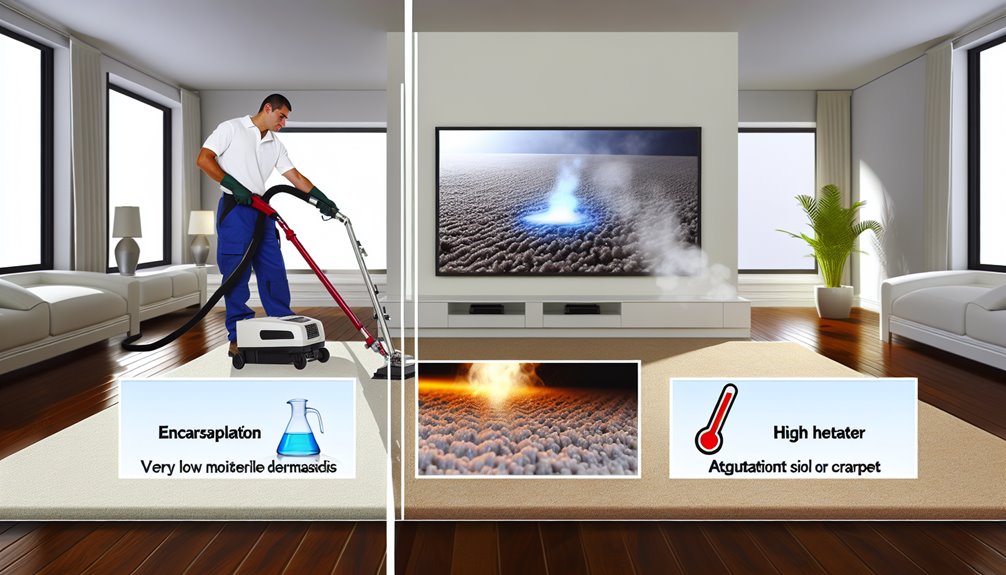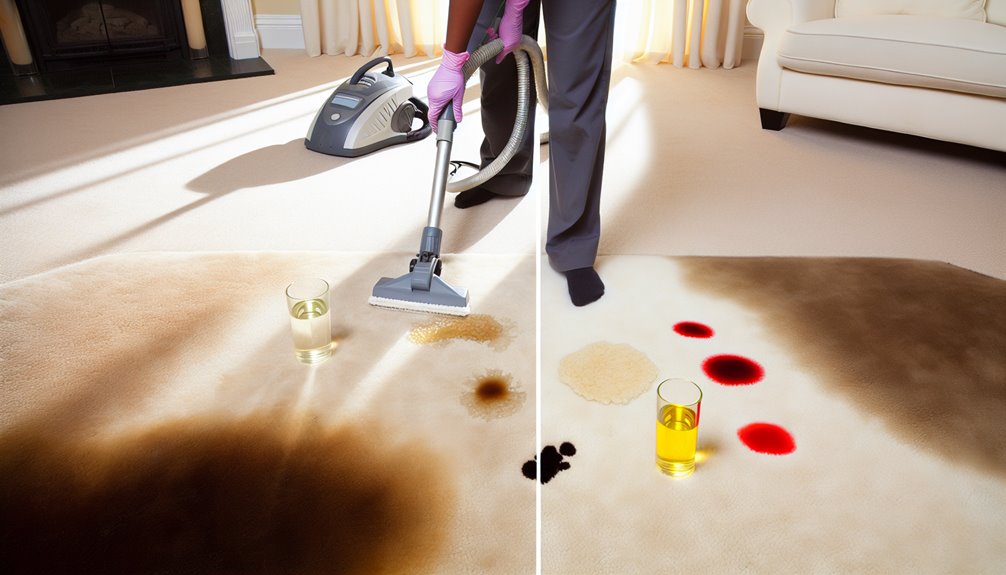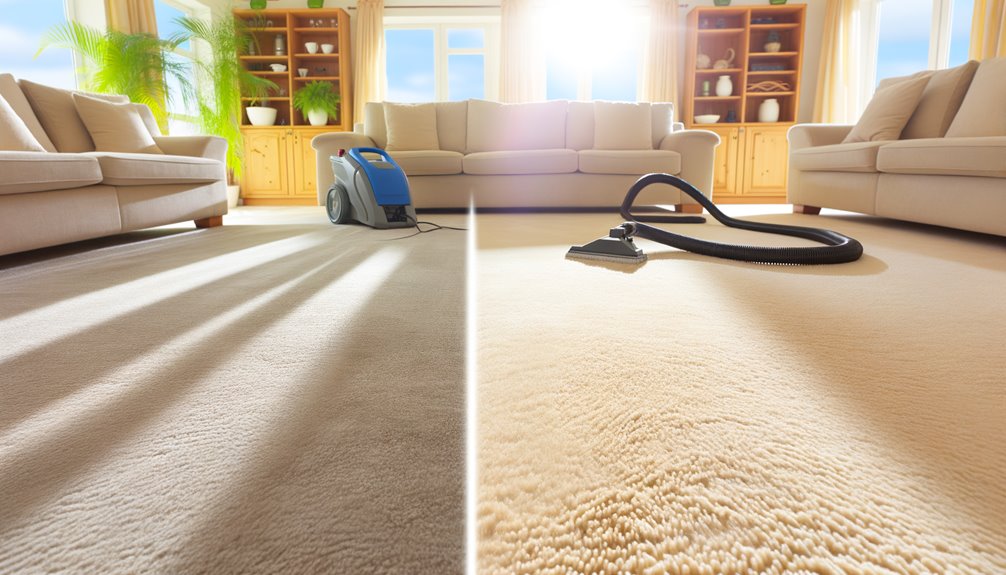Choosing between very low moisture (VLM) and steam (hot water extraction) hinges on soil load, fiber chemistry, and indoor air quality goals. You’ll weigh engineered detergency and pad absorption against heat, rinse-extraction, and thorough drying protocols. The right choice shifts with stain type, pile density, and humidity. Pick wrong, and you risk wicking, residue, or microbial growth. Pick right, and you extend carpet life and cut allergens. Here’s how the mechanics—and standards—guide that decision.
How VLM and Steam Lift Soil: Chemistry, Heat, and Agitation

Whether you choose very low moisture (VLM) or hot-water extraction (steam), both methods remove soil through the same three mechanisms: chemistry, heat, and agitation. You start with chemistry—detergents, emulsifiers, and enzymatic binders targeted to soils identified by fiber type and pH tolerance per IICRC standards. Heat accelerates reaction rates, lowers viscosity, and improves wettability, aiding particle suspension and dispersion. Agitation—counter-rotating brushes or wand strokes—increases mechanical energy, dislodging adherent soils and distributing chemistry uniformly. You then recover suspended soils through absorption (VLM pads) or fluid extraction (steam). Proper dwell, measured dilution, and controlled passes guarantee consistent, service-oriented, verifiable outcomes.
Moisture Dynamics and Drying Times: What Happens in the Fibers
Although both methods introduce water into the pile, what happens next hinges on fiber chemistry, construction, and environmental conditions. You manage moisture where it resides: on filaments, within capillaries, and at backing interfaces. Hydrophilic nylon shows greater fiber swelling and slower diffusion than olefin; wool retains bound water yet vents efficiently through crimps. VLM limits liquid bridges, shortening capillary hold times. Steam adds heat, accelerating diffusion yet increasing initial load.
You accelerate drying by maximizing evaporation pathways: lift pile, increase air exchange, and control dew point. Extract thoroughly, then balance airflow and temperature per IICRC S100 guidance. Verify with moisture meters to protect backing and subfloor.
Stain Types and Spotting Strategies for Each Method

Drying mechanics inform how stains behave next: heat, moisture load, and fiber chemistry govern solubility, wicking, and set. You’ll classify by chemistry: protein/tannin, oil-based, dye/track, and particulate. For VLM, use controlled enzymatic prespotting for proteins, solvent boosters for oils, and encapsulation to arrest wicking; tamp, then pad-extract. For steam (HWE), meter heat and rinse rate to reduce dispersion; apply acidic rinses for tannins and alkaline-emulsifier for grease, then rinse-extract with low over-wet risk. Perform dye stabilization on vulnerable fibers before treating colored spills. Blot metals/rust with reducing agents; oxidize organic discolorations judiciously. Always test inconspicuous areas and document pH, dwell, and results.
Allergen and Indoor Air Quality Considerations
Because carpet systems act as reservoirs for bioaerosols, your cleaning method directly affects allergen loads and indoor air quality per ASHRAE and IICRC S100 guidance. You’ll reduce airborne allergens most when you pair precision soil removal with controlled moisture and verified drying times. VLM limits humidity spikes; steam (HWE) extracts deeper but requires stronger dehumidification and ventilation impact management.
- Use sealed HEPA vacuums pre- and post-cleaning to capture submicron particulates.
- Verify drying within 6–12 hours; deploy air movers and dehumidifiers to prevent microbial amplification.
- Choose EPA-registered, residue-minimizing chemistries; rinse or pad-extract thoroughly to avoid sticky residues that re-aerosolize particles.
Matching Method to Carpet Type and Construction

Start by aligning your cleaning approach with the carpet’s fiber chemistry, dye system, pile construction, and backing, as specified in CRI, IICRC S100, and manufacturer bulletins. You’ll choose VLM or hot-water extraction based on pile density, twist level, and backing compatibility. For olefin and solution-dyed nylon, VLM encapsulation limits wicking and color risk. For wool and jute-backed goods, controlled-moisture extraction with neutral pH and rapid drying protects dimensional stability. Dense, low-pile commercial tiles favor VLM; deep, cut-pile residential styles benefit from calibrated steam with thorough rinse and grooming. Always confirm adhesives’ tolerance to moisture, heat, and alkalinity before proceeding.
Kids, Pets, and High-Traffic Homes: Practical Method Selection
You’ve matched methods to construction; now apply that logic to the real-world load of kids, pets, and constant footfall. Prioritize rapid dry times to reduce resoiling and slip risk. Use VLM for interim maintenance in activity zones; deploy steam (hot water extraction) for periodic restorative flushing of residues and allergens per IICRC S100.
- Choose VLM pads with encapsulants for daily soil, then schedule quarterly steam to reset baseline.
- Treat accidents immediately with child safe spotters; verify pH, residue profile, and fiber compatibility.
- Specify pet-targeted deodorizers with enzyme action; extract thoroughly to backing when contamination reaches pad.
Avoiding Common Pitfalls and Maximizing Long-Term Cleanliness

Although VLM and steam complement each other, you’ll prevent most failures by controlling chemistry, moisture, and soil load per IICRC S100. Dose detergents by manufacturer CTAs, verify pH compatibility with fiber type, and avoid sticky residues that accelerate resoiling. Meter water; target even, light application for VLM and controlled dwell with sub-15% moisture recovery for steam.
Standardize dry soil removal—eliminate neglecting routine vacuuming with CRI Gold equipment and frequent passes. Rotate agitation tools to prevent pile distortion. Rinse or pad-extract thoroughly to remove surfactant films. Don’t risk overuse of protectant sprays; apply only to clean, dry fibers at specified coverage, then groom and verify dryness.
Conclusion
At Hydra Clean, we believe in delivering the best results for your carpet care. Whether you need routine maintenance or a deep clean, we have the right solution for your needs. I invite you to visit myhydraclean.com or give us a call at (601) 336-2411 to learn more about how we can help you extend the life of your carpets and create a healthier home environment. I look forward to speaking with you and helping you achieve the cleanliness you deserve!

